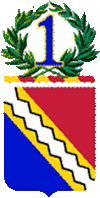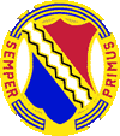

 |
The 1st Infantry Regiment |  |
|---|
The 1st Infantry Regiment dates back to 1791 when it was designated as "The Second Regiment of Infantry" in New England and is the second oldest unit in the Army. In September, 1791, elements of the 2nd and the original "First Regiment of Infantry" (today’s 3d United States Infantry Regiment), with sizable militia complements, were sent to fight against the Miami indians. The soldiers were untrained, ill equipped, under-fed, and sickly. This resulted in a disastrous defeat, at the "Battle of the Wabash", in which the entire U.S. Army suffered a loss in killed and wounded of nearly 900 out of a total strength of 1400. It was (and remains) the greatest defeat in the history of the U.S. Army.In 1792 it was designated as the "Infantry of the 2nd Sub-legion" and, in 1796 it was again redesignated as the 2nd Infantry.
In 1792, Congress created the Legion of the United States, which was a combined arms force of infantry, cavalry, and artillery. This Legion in which the Second Infantry became the "Infantry of the Second Sub-Legion," crushed the Miami Nation during 1792 to 1795, and finally defeated the Indians in a decisive manner at Fallen Timbers in the Old Northwest (Ohio) on August 20, 1794.
The War of 1812 saw the 2nd, 7th, and 44th Infantry Regiments deployed in the southern theater including the "Battle of New Orleans" with General Andrew Jackson. The 2nd Infantry was consolidated in 1815 with the 3rd, 7th, and 44th Infantries to form the 1st Infantry Regiment. In the ensuing years the Regiment was primarily concerned with Indian conflicts and the 1st was involved in the "Black Hawk War of 1832" and the "Second Seminole War" from 1839 to 1842. During this time the Regiment was commanded by one of its most famous commanders in history, Colonel Zachary Taylor, who would later become the 12th President of the United States.
When War broke out with Mexico in 1846, the 1st Infantry was sent across the border with General Zachary Taylor's Army and participated in the storming of Monterrey where the Regiment fought house to house in savage hand to hand combat. Another notable figure who fought with the 1st was Jefferson Davis, later to be President of the Confederate States of America. From Monterrey the regiment was transferred to General Winfield Scott's command and participated in the first modern amphibious landing in American history at Vera Cruz in 1847.
Following the "Mexican War", the "Second Indian War Period" began and the Regiment campaigned in the Texas area against the Comanches until the outbreak of the Civil War in 1861. Escaping rebel forces being formed in Texas, the regiment moved to the east into the Mississippi area fightingt in one of the first battles of the Civil War at Wilson's Creek, Missouri, in August 1861. The regiment then campaigned with General Grant against Vicksburg in 1863 and the end of the War found the Regiment occupying New Orleans, Louisiana.
After the Civil War, the regiment was sent west to fight the Indians once again and fantry was consolidated, in April 1869, with the 43d Infantry Regiment and the "Veteran Reserve Corps" retaining its 1st Infantry Regiment designation. The regiment campaigned against the Sioux in the 1870s and 1890s and against the Apache, led by Geronimo, from 1882 to 1886. At the end of the Indian wars, the regiment was occupied with quelling labor disputes in California and in 1898, when war was declared with Spain following the sinking of the USS Maine, the 1st was sent to Florida where it embarked on ships and was sent to Cuba. While in Cuba the regiment took part in the storming of the San Juan Heights and the capture of Santiago remaining on occupational duty there. While in Cuba, the regiment was prepared for shipment to China to participate in the Boxer Rebellion but was, instead, ordered to the Philippine Islands to with a rebellion within the islands. The Philippines, captured by the United States in the "Spanish-American War", would find the regiment fighting in a guerrilla warfare from 1900–1902 and again from 1906-1908. After the Spanish-American War, the unit was assigned garrison duty in Oahu, Hawaii.
The 1st Infantry Regiment was assigned to the 13th Infantry Division at Fort Lewis in September, 1918 and demobilized there in 1919. The regiment was relieved from assignment to the 13th Division and assigned "Separate Regiment" status in 1927 to the 2nd Infantry Division (part of the U.S. VIII Corps) headquartered at Fort Sam Houston. The regiment moved to Camp Jackson, South Carolina and assigned to the 6th Infantry Division. The 6th Division arrived at Fort Jackson on November 9th, 1939 and the regiment was with the 6th throughout World War II until deactivated on January 10, 1949.
The regiment moved to Fort Benning, Georgia with the 6th and participated in a series of training maneuvers in the Louisiana/Texas area; moving to Fort Francis E. Warren, Fort Leavenworth, Fort Leonard Wood and to Tennessee for more maneuvers. They were then trained at the Desert Training Center at Camap Young and finally staged at Camp San Luis Obispo, California departing San Francisco for Hawaii. The regiment left Hawaii at the end of January, 1944 arriving at Milne Bay, New Guinea on February 7th, moving to Toem 2 weeks later and participating in the assualt on Sansapor at the end of July. A Presidential Unit Citation was awarded for the regiments actions at Milne Bay. With the end of the New Guinea Campaign on July 31st, the regiment was shipped to the Philippines and assaulted Lingayen gulf on the island of Luzon. After a 2 week rest, the regiment returned to the Luzon Campaign which concluded on July 4, 1945. The regiment moved to Korea during October, 1945 and remained in occupation there until the end of 1949.
The regiment was reactivated in October, 1950 at Fort Ord, California to train units being sent to the fight in Korea. On April 3, 1956, the Regiment was relieved from assignment to the 6th Infantry Division, and then was assigned on May 15, 1956 to the United States Military Academy at West Point. On May 15, 1958 the Regiment was reorganized under the Combat Arms Regimental System as HHC, 1st Battle Group, 1st Infantry Regiment. In 1960, the 1st Battle Group, 1st Infantry was reorganized again and it left the Battle Group with a Headquarters, Headquarters and Training Company, Service Company, Airborne Detachment, the 2nd Aviation Detachment, the USMA Band, Detachment 1 and 2 United States Army Hospital, and saw the attachment of the 50th Engineer Battalion (Construction) and the 57th Military Police Company. The old Military Police Detachment personnel formed the nucleus of the newly attached 57th Military Police Company. On May 16. 1961, the mission of providing tactical instruction for the Corps of Cadets along with the personnel involved, was transferred to a newly created Office of Military Instruction in the Department of Tactics. All enlisted personnel remained assigned to the Battle Group. On February 1, 1962, Service Company was eliminated and its personnel absorbed into Headquarters Company. On January 1, 1965, the 1st Battle Group, 1st Infantry was redesigned as the 1st Battalion, 1st Infantry its mission was essentially unchanged. The 2nd Battalion was assigned to Fort Benning, Georgia: the 3rd Battalion was inactivated then reactived in 1966 and assigned to the 11th Light Infantry Brigade in 1967.
In 1966, the 2nd Battalion was deployed to Vietnam and, the following year, the 3rd Battalion arrived with the 11th LIB. These two battalions earned fourteen campaign streamers for the regiment during the war in Vietnam. Also in 1967, the 4th, 5th, and 6th Battalions of the 1st Infantry Regiment were assigned to the 6th Infantry Division at Fort Campbell, Kentucky and relieved from assignment to the 6th Infantry Division in July, 1968 and inactivated on July 21st, 1969. The 11th Infantry Brigade returned to the United States in 1971, at which time 3rd Battalion was deactivated.
The 196th Infantry Brigade was the last combat brigade to leave Vietnam in June 1972. Following its tour of duty in Vietnam, the 2nd Battalion was sent to Fort Lewis, Washington, where it became part of the 9th Infantry Division. In January 1991 the battalion became part of the 199th Light Infantry Brigade at Fort Polk, Louisiana, where it remained until inactivation in 1994. On 16 December 1995 the 2nd Battalion was reactivated at Fort Wainwright as part of the 6th Infantry Division (Light), which was redesignated as the 172nd Infantry Brigade (Separate) in April 1998.
In August, 2005, the 2nd Battalion was deployed with the 172nd Stryker Brigade to Mosul, Iraq in support of "Operation Iraqi Freedom". After 12 months in Mosul, the Stryker Brigade was sent to Baghdad for another 4 months before returning to the United States. The Stryker Brigade was officially inactivated and the 1st Stryker Brigade Combat Team, 25th Infantry Division was activated in its place on 14 December 2006. The brigade's six battalions and four separate companies were likewise reflagged as part of the change. The 2nd Battalion, 1st Infantry Regiment was reflagged to 1st Battalion, 24th Infantry Regiment.
The 1st Battalion, 24th Infantry Regiment returned to Fort Lewis from Iraq in September 2005. It was inactivated on 1 June 2006 with its personnel and equipment being transferred to the 2nd Cavalry Regiment (Stryker). On 16 December 2006 the 1st Battalion was reactivated as an element of the 1st Brigade Combat Team (Stryker), 25th Infantry Division at Fort Wainwright, Alaska using the personnel and equipment of the inactivating 2nd Battalion, 1st Infantry Regiment.
References:
U.S. Army Center of Military History
Wikipedia, World War II-Time Life Books
The National Historical Society Publications